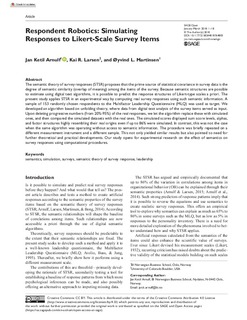Respondent Robotics: Simulating responses to Likert-scale survey items
Journal article, Peer reviewed
Published version
Permanent lenke
http://hdl.handle.net/11250/2496713Utgivelsesdato
2018Metadata
Vis full innførselSamlinger
- Publikasjoner fra CRIStin - BI [1015]
- Scientific articles [2181]
Sammendrag
The semantic theory of survey responses (STSR) proposes that the prime source of statistical covariance in survey data is the degree of semantic similarity (overlap of meaning) among the items of the survey. Because semantic structures are possible to estimate using digital text algorithms, it is possible to predict the response structures of Likert-type scales a priori. The present study applies STSR in an experimental way by computing real survey responses using such semantic information. A sample of 153 randomly chosen respondents to the Multifactor Leadership Questionnaire (MLQ) was used as target. We developed an algorithm based on unfolding theory, where data from digital text analysis of the survey items served as input. Upon deleting progressive numbers (from 20%-95%) of the real responses, we let the algorithm replace these with simulated ones, and then compared the simulated datasets with the real ones. The simulated scores displayed sum score levels, alphas, and factor structures highly resembling their real origins even if up to 86% were simulated. In contrast, this was not the case when the same algorithm was operating without access to semantic information. The procedure was briefly repeated on a different measurement instrument and a different sample. This not only yielded similar results but also pointed to need for further theoretical and practical developments. Our study opens for experimental research on the effect of semantics on survey responses using computational procedures.
